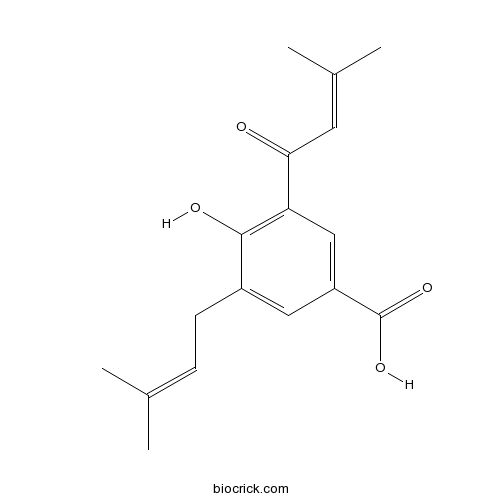4-Hydroxy-3-(3-methyl-2-butenoyl)-5-(3-methyl-2-butenyl)benzoic acidCAS# 155051-85-7 |

Quality Control & MSDS
3D structure
Package In Stock
Number of papers citing our products

| Cas No. | 155051-85-7 | SDF | Download SDF |
| PubChem ID | 44241609 | Appearance | Yellow powder |
| Formula | C17H20O4 | M.Wt | 288.3 |
| Type of Compound | Phenols | Storage | Desiccate at -20°C |
| Solubility | Soluble in Chloroform,Dichloromethane,Ethyl Acetate,DMSO,Acetone,etc. | ||
| Chemical Name | 4-hydroxy-3-(3-methylbut-2-enoyl)-5-(3-methylbut-2-enyl)benzoic acid | ||
| SMILES | CC(=CCC1=CC(=CC(=C1O)C(=O)C=C(C)C)C(=O)O)C | ||
| Standard InChIKey | MRQCEQPYILVFQS-UHFFFAOYSA-N | ||
| General tips | For obtaining a higher solubility , please warm the tube at 37 ℃ and shake it in the ultrasonic bath for a while.Stock solution can be stored below -20℃ for several months. We recommend that you prepare and use the solution on the same day. However, if the test schedule requires, the stock solutions can be prepared in advance, and the stock solution must be sealed and stored below -20℃. In general, the stock solution can be kept for several months. Before use, we recommend that you leave the vial at room temperature for at least an hour before opening it. |
||
| About Packaging | 1. The packaging of the product may be reversed during transportation, cause the high purity compounds to adhere to the neck or cap of the vial.Take the vail out of its packaging and shake gently until the compounds fall to the bottom of the vial. 2. For liquid products, please centrifuge at 500xg to gather the liquid to the bottom of the vial. 3. Try to avoid loss or contamination during the experiment. |
||
| Shipping Condition | Packaging according to customer requirements(5mg, 10mg, 20mg and more). Ship via FedEx, DHL, UPS, EMS or other couriers with RT, or blue ice upon request. | ||
| In vitro | Dihydrochalcones and benzoic acid derivatives from Piper dennisii.[Pubmed: 22516933]Planta Med. 2012 Jun;78(9):914-8.
|

4-Hydroxy-3-(3-methyl-2-butenoyl)-5-(3-methyl-2-butenyl)benzoic acid Dilution Calculator

4-Hydroxy-3-(3-methyl-2-butenoyl)-5-(3-methyl-2-butenyl)benzoic acid Molarity Calculator
| 1 mg | 5 mg | 10 mg | 20 mg | 25 mg | |
| 1 mM | 3.4686 mL | 17.343 mL | 34.6861 mL | 69.3722 mL | 86.7152 mL |
| 5 mM | 0.6937 mL | 3.4686 mL | 6.9372 mL | 13.8744 mL | 17.343 mL |
| 10 mM | 0.3469 mL | 1.7343 mL | 3.4686 mL | 6.9372 mL | 8.6715 mL |
| 50 mM | 0.0694 mL | 0.3469 mL | 0.6937 mL | 1.3874 mL | 1.7343 mL |
| 100 mM | 0.0347 mL | 0.1734 mL | 0.3469 mL | 0.6937 mL | 0.8672 mL |
| * Note: If you are in the process of experiment, it's necessary to make the dilution ratios of the samples. The dilution data above is only for reference. Normally, it's can get a better solubility within lower of Concentrations. | |||||

Calcutta University

University of Minnesota

University of Maryland School of Medicine

University of Illinois at Chicago

The Ohio State University

University of Zurich

Harvard University

Colorado State University

Auburn University

Yale University

Worcester Polytechnic Institute

Washington State University

Stanford University

University of Leipzig

Universidade da Beira Interior

The Institute of Cancer Research

Heidelberg University

University of Amsterdam

University of Auckland

TsingHua University

The University of Michigan

Miami University

DRURY University

Jilin University

Fudan University

Wuhan University

Sun Yat-sen University

Universite de Paris

Deemed University

Auckland University

The University of Tokyo

Korea University
- Usaramine
Catalog No.:BCN2121
CAS No.:15503-87-4
- Isatidine
Catalog No.:BCN2120
CAS No.:15503-86-3
- Pancuronium dibromide
Catalog No.:BCC4578
CAS No.:15500-66-0
- Ac-Arg-OH.2H2O
Catalog No.:BCC2855
CAS No.:155-84-0
- Rhaponiticin
Catalog No.:BCN5392
CAS No.:155-58-8
- Methscopolamine
Catalog No.:BCC4577
CAS No.:155-41-9
- RU 58841
Catalog No.:BCC1911
CAS No.:154992-24-2
- Erysenegalensein E
Catalog No.:BCN3979
CAS No.:154992-17-3
- BAY-u 9773
Catalog No.:BCC7576
CAS No.:154978-38-8
- LL 37
Catalog No.:BCC8027
CAS No.:154947-66-7
- Kaempferol 3,7,4'-trimethylether
Catalog No.:BCN4087
CAS No.:15486-34-7
- 3,5-Dihydroxy-4',7-dimethoxyflavone
Catalog No.:BCN1691
CAS No.:15486-33-6
- N-[2-(Piperidinylamino)ethyl]-4-iodobenzamide
Catalog No.:BCC6784
CAS No.:155054-42-5
- SM-21 maleate
Catalog No.:BCC6780
CAS No.:155059-42-0
- 24,25-Dihydroxycycloartan-3-one
Catalog No.:BCN1692
CAS No.:155060-48-3
- 11-Deoxyalisol B
Catalog No.:BCN3359
CAS No.:155073-73-7
- 6-ethyl-3-methyl-4-oxo-4H-pyran-2-carboxylic acid
Catalog No.:BCC8270
CAS No.:1551-49-1
- 2-[1-(4-Piperonyl)piperazinyl]benzothiazole
Catalog No.:BCC6771
CAS No.:155106-73-3
- Rosiglitazone maleate
Catalog No.:BCC2262
CAS No.:155141-29-0
- Plerixafor 8HCl (AMD3100 8HCl)
Catalog No.:BCC4447
CAS No.:155148-31-5
- Plerixafor octahydrobromide
Catalog No.:BCC9123
CAS No.:155148-32-6
- Physapruin A
Catalog No.:BCN7576
CAS No.:155178-03-3
- Cordifolioside A
Catalog No.:BCN8224
CAS No.:155179-20-7
- Cinnamylideneacetic acid
Catalog No.:BCN7777
CAS No.:1552-94-9
Dihydrochalcones and benzoic acid derivatives from Piper dennisii.[Pubmed:22516933]
Planta Med. 2012 Jun;78(9):914-8.
Two new dihydrochalcones (1, 2), as well as eight known compounds, piperaduncin C (3), 2',6'-dihydroxy-4'-methoxydihydrochalcone (4), 4,2',6'-trihydroxy-4'-methoxydihydrochalcone (5), 4-hydroxy-3,5-bis(3-methyl-2-butenyl)-benzoic acid (6), 3,5-bis(3-methyl-2-butenyl)-4-methoxybenzoic acid (7), 4-hydroxy-3-(3-methyl-2-butenoyl)-5-(3-methyl-2-butenyl)-benzoic acid (8), 2,2-dimethyl-8-(3-methyl-2-butenyl)-2H-1-chromene-6-carboxylic acid (9), and 3-(3',7'-dimethyl-2',6'-octadienyl)-4-methoxybenzoic acid (10) were isolated from the leaves of Piper dennisii Trelease (Piperaceae), using a bioassay-guided fractionation to determine their antileishmanial potential. Among them, compound 10 exhibited the best antileishmanial activity (IC50 = 20.8 microM) against axenic amastigote forms of Leishmania amazonensis, with low cytotoxicity on murine macrophages. In the intracellular macrophage-infected model, compound 10 proved to be more active (IC50 = 4.2 microM). The chemical structures of compounds 1-10 were established based on the analysis of the spectroscopic data.


